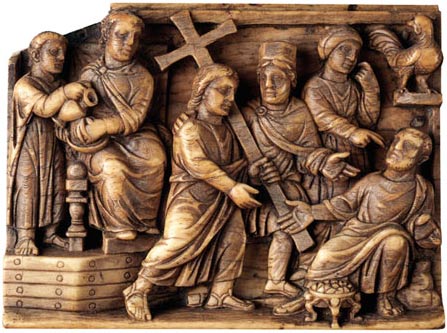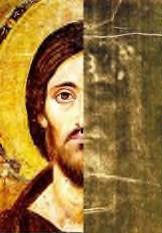December
2012 - Vol. 64

Christ
and Pilate, Peter's denial, ivory relief sculpture, 400 AD
Christ
Ruler of All
portraying the Lord
in early Christian art
by
Don Schwager
The depiction
of the Lord Jesus Christ in art goes back as early as the second century
AD. One of the earliest known images, depicted in numerous 2nd century
paintings and sculpture, is the figure of the Good Shepherd with a lamb
around his shoulders, representing Christ's care for those he has saved
(see photo below on the right).
In the 3rd
and 4th centuries, more varied images of Christ and scenes from the New
Testament Gospels appear, as well as scenes from the Old Testament. Depictions
of Christians at prayer with raised hands and the Agape feast also appear
at this period. The use of icons in homes and churches became widespread
in the 4th and 5th centuries.
The iconoclast
wars, first among Eastern Christians in the 8th century and later during
the Reformation in the West, centered on the Old Testament prohibition
of graven images (Exodus 20:4). Christians have argued for and against
images of Christ ever since. The fact of the Incarnation –
God becoming man and taking on human flesh –
has inspired artists throughout the centuries to recount the Gospel accounts
of Christ as well as other biblical stories throughout the Old and New
Testaments.
Icon
of Christ Pantocrator (Ruler of All)
“Christ Pantocrator”
is one of the earliest surviving icons of Jesus Christ (see top photo on
right). It dates from the early 500s (6th century AD) and is housed in
the church at St. Catherine's Monastery, Mount Sinai, Egypt. The Greek
word
pantocrator means “ruler of all.” The icon is painted with
colored beeswax applied with spatula (encaustic technique) onto a wooden
panel and measures 84 cm by 45.5 cm.
In the icon
image, Christ is robed in a purple tunic, a color which signifies royalty.
He is holding a copy of the Gospels in his left hand while his right hand
is raised in blessing. The icon depicts Jesus Christ as both Ruler of all,
thus our Judge, and as Savior of the world who brings us the Gospel, the
good news of salvation and life-giving Word of God.

The eyes are
asymmetrical, most likely to contrast the two natures of Christ as both
human
and divine – and to depict
on the one hand the Judge who sees all (nothing remains hidden to
him), and at the same time he is the Savior who looks upon us with
mercy.

image on the Shroud of Turin
(right side)
matches the face of Christ
Pancrator icon
The face painted
on the icon was most likely copied from the Image of Edessa (also
called the Myron or Holy Mandylion), a rectangular piece
of cloth with an image of the face of Christ on it, kept in the Greek city
of Odessa in the 4th century, but has subsequently been lost. It was believed
to be the rectangular piece of cloth that covered the face of Jesus for
his burial. The facial image on the Shroud of Turin, which is believed
to be the full burial shroud of Jesus, also matches the image of the face
of Christ in the icon.